Editor's Note:
Dear Friend,
This is a dangerous confession: I rewrite the Daily Doses continuously.
Over 1,000 Daily Doses of Wisdom have accumulated since I started writing them in 1994. And whenever it’s their turn to reappear, they each get a review—and usually a rewrite.
Why? Because I look at something I wrote three years ago and say, “No, that’s not it!” And I edit, discard and rewrite until I say, “Yes!” And then, three years later, I look again and say, “No, no, no.” So I rewrite again.
Not that it was wrong the first time. Or the second. Or the third. They’re not my ideas—they’re Torah ideas. But, hey, if you’re alive, you can’t stand still. And if I’m moving forward, then the way I grasp an idea has to move with me.
That’s what it says about the divine voice we heard at Sinai: “There was a great voice that never stopped.” Every day, every moment, it’s speaking to us the same words with the same thunder and lightning—no difference. Torah doesn’t change—but you change, you grow, you are a new person each day. And so, every day, you look at all the Torah you ever learned and you say, “Wow. I never really understood this before!”
How about you? Do you revisit the things that you learned yesterday, or last year, or when you were younger? Or do you find yourself saying, “That? I learned that already!” Are you still at Sinai?
Tzvi Freeman,
on behalf of the Chabad.org Editorial Team
Yitro

Untraditional LifeThese words that I command you today should be upon your heart.[Deuteronomy 6:6.]
Every day, the words of the Torah must be new to you.
Sifri, Rashi.
Tradition is not life. Tradition preserves life. But it does not give life.
Goals are not life. Goals inspire life. But they are not life.
Life is here in this moment now. To be alive, every moment must be a moment that never happened before.
Which means that Torah must not be about tradition. It cannot be grounded on a memory of the past. Those are important, truly vital. But a Torah life cannot be built upon them.
Real life, Torah life, is about who you are now, where the core of your soul lies at this very moment.
For if it is not about the moment now, then it is not your life. And if it is not your life, then what is?[Maamar Tziyon BeMishpat 5736.]
Story
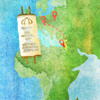
From Auschwitz to Israel, the Saga of a Long-Lost Mini-Torah
By Shlomo Rizel
How a journalist made a priceless personal discovery, spattered in his grandfather’s blood.

When the Rabbi Made a Mistake
By Yanki Tauber
His detractors pounced on him, demonstrating how his verdict contradicts a principle of Torah law.
Focus on Special Needs
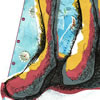
Lenny’s Gift
By Chana Perman
The story of a man who lived in the hospital

To the Mother of a Child with Autism
By Aron Moss
I had big plans for him. Well, my plan is not working out.
Women
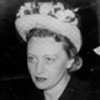
A Private Life of Public Service
By Eli Rubin
Unlike her husband, Rebbetzin Chaya Mushka did not practice her dedication to the Jewish people in the public eye, but in the privacy of her own home.

G-d Doesn’t Need You
By Sara Blau
As a mother, there are oh so many things to worry about.

A Tree Grows in Brooklyn
By Chaya Shuchat
I live in a neighborhood with a synagogue on every street corner. Still, I have a spiritual hunger that can be assuaged only by contact with nature.
Parshah

How TV Watching Fueled My Spiritual Path
By Lieba Rudolph
On my first trip to Israel in 1978, my traveling companion wanted to climb Mt. Sinai . . .

How to Have a Healthy Relationship
by Chana Slavaticki
Finding the balance betwee the love and fear of G‑d.
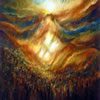
Parshah Art: The Giving of the Torah
By Yoram Raanan
Lifestyle
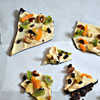
Make Some Colorful, Eye-Catching Fruit Bark for Tu B'Shevat
By Miriam Szokovski
Question

Why Is Tu B’Shevat in the Winter?
By Yehuda Shurpin
Why celebrate trees when nothing is growing?
Jewish News
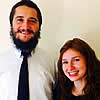
Where to Hang Out if You Speak English in Tel Aviv
By Carin M. Smilk
Near the beach and hotels, a new Chabad center focuses on serving English-speakers in Israel and draws young adults from all over the world.
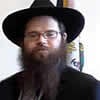
Rabbi Behind Bars
By Eric Berger, Chabad.edu
Working with college students on campus, and also prison inmates over Shabbat.
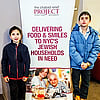
Helping the Hungry in New York, Especially During Blizzard
By Karen Schwartz
Growing monthly effort to distribute kosher food to the those in need.
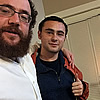
Green in Eugene
By Reuvena Leah Grodnitzky, Chabad.edu
Couple receives a sunny welcome in the rainy Pacific Northwest.
Chabad.org Magazine - Editor: Yanki Tauber
© Copyright 2016, all rights reserved.
This Week's Features:
Printable Magazine

A Private Life of Public Service
A tribute to Rebbetzin Chaya Mushka Schneerson, whose yartzeit is on 22 Shevat
By Eli Rubin
<script language="javascript" type="text/javascript" src="http://embed.chabad.org/multimedia/mediaplayer/embedded/embed.js.asp?aid=3190727&width=auto&height=auto"></script><span style="clear:both;" class="lb" id="lbdiv">Visit <a href="http://www.chabad.org/multimedia/default_cdo/aid/591213/jewish/Video.htm">Jewish.TV</a> for more <a href="http://www.chabad.org/multimedia/default_cdo/aid/591213/jewish/Video.htm">Jewish videos</a>.</span>
About the Course:
A Private Life of Public Service
A tribute to Rebbetzin Chaya Mushka Schneerson, whose yartzeit is on 22 Shevat
By Eli Rubin

<script language="javascript" type="text/javascript" src="http://embed.chabad.org/multimedia/mediaplayer/embedded/embed.js.asp?aid=3190727&width=auto&height=auto"></script><span style="clear:both;" class="lb" id="lbdiv">Visit <a href="http://www.chabad.org/multimedia/default_cdo/aid/591213/jewish/Video.htm">Jewish.TV</a> for more <a href="http://www.chabad.org/multimedia/default_cdo/aid/591213/jewish/Video.htm">Jewish videos</a>.</span>
The Shema is perhaps the best-known Jewish prayer. The last words of millions of Jews as they were massacred at the hands of the Greeks, burned at the stake in Spain and gassed in German extermination camps. We say it every morning and every night.
But why? What is it about these words that encapsulates the core of Jewish belief?
Does G‑d leave things up to fate, or does He really micromanage every aspect of existence? Why did G‑d create the world? What purpose does it serve Him? What is our purpose?
In this course you will learn answers to these burning questions. Gain a deeper appreciation for G‑d, the world around you, and your place in it all.
What You'll Learn:
- How to have a relationship with G‑d
- How to maintain motivation in fulfilling our purpose
- Why G‑d cares about our world
- Why G‑d is constantly involved in the world
- The deeper meaning of the Shema
Lesson 1: G‑d, One or Only?
January 18, 2016
In this class you will study the Chassidic elucidation of the grammatical choice of the word echad ("one") in the Shema, in contrast to yachid ("singular"), and the significant implication of this to G‑d's relationship with creation.
Lesson 2: Sinaitic Spirituality vs. Today's Experience
January 25, 2016
You will learn what really happened at Sinai when G‑d came down on a mountaintop. What was the reality of our ancestors at that time? In what way is it different from what we experience today? What does G‑d need us for anyway? See how all this is packed into the single word of echad.
Lesson 3: G‑d vs. Man
February 1, 2016
You will examine the notion of "constant recreation," whereby G‑d creates the universe from nothing every moment. To understand this, you will learn the key difference between human creation and divine creation.
Lesson 4: When and Where G‑d Is Found?
February 8, 2016
Based on what you've learned, you will now answer the question of how anything can exist in the face of an infinite G‑d.
Q & A with Rabbi Kornfeld
February 15, 2016
Rabbi Kornfeld will attempt to explain any concepts which require more attention, as well as your questions, to close out the course.
What Is Kabbalah:
Inside your body breathes a person—a soul. Inside the body of Jewish practice breathes an inner wisdom—the soul of Judaism. We often call it Kabbalah, meaning "receiving." Just as Jewish practice is received through an unbroken, ancient tradition from the revelation at Sinai, so is its soul. Kabbalah, then, is the received wisdom, the native theology and cosmology of Judaism. Read more...
What Is Chassidut:
Chassidus (or Chassidut) is the inner dimension of Torah, explored and taught by the Chassidic masters. . Read more...
Additional Resources:
- Oneness and the Infinite
- G‑d is One - The Shema Prayer (Audio Class)
- What Is G‑dliness?
- What Is G‑d?
Level: Introductory / Intermediate
Length: 5 weeks
Effort: 35 minutes per week
Category: Kabbalah/Chassidut
Insitution: Chabad.org | Jewish.tv
Language: English
Cost: FREE
(Suggested Donation $18)
Registration Required
Meet the Instructor:
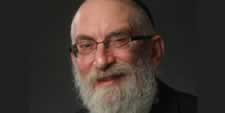
Rabbi Yechezkel Kornfeld received his rabbinic ordination from the Central Yeshiva Tomchei Tmimim Lubavitch in Brooklyn, N.Y. He was profoundly influenced by the legendary chassidic teacher, Rabbi Shlomo Chaim Kesselman of Kfar Chabad, Israel. He also studied in the Rabbi Isaac Elchanan Theological Seminary (RIETS), the theological department of Yeshiva University (YU).
Rabbi Kornfeld currently lives with his wife Devorah in Mercer Island, Wash. An affiliate Shliach of Chabad Lubavitch of the Pacific Northwest since 1975 and a member of the Rabbinic Council of Seattle, he has served as rabbi of Shevet Achim Congregation of Mercer Island, WA since 2003.
Register for this Course:
Sign up for this new exciting course. The cost is free!
☑ Yes! I would like to register for this course.
First Name
Last Name
Email Address
Please send me Chabad.org's periodic emails. We will not share your email address.
---------------------
Story
| ||
When Israeli journalist Yaakov Maor was sent to Vienna 40 years ago to write about the first stirrings of the newly founded European Economic Union, he couldn’t have guessed that the trip would result in a priceless discovery with deep personal significance.
A financial reporter for the Maariv newspaper, Maor—then in his 20s—visited the Mizrachi Synagogue daily for prayers. He piqued the interest of the rabbi, who asked him to speak to the congregation about Israel. So he spoke about life there—about the country’s natural beauty, and about the Yom Kippur War, which had recently ended. He also spoke about a group of idealistic young families who were re-establishing ancient Jewish towns on the West Bank of the Jordan River. The synagogue’s president became excited about building communities on the ruins of cities that had been razed at the time of the destruction of the Second Temple, and expressed his desire to help. Maor phoned some friends in Israel to find out how the Vienna Jewish community could assist them in strengthening the new settlements. The answer: Torah scrolls. “Elon Moreh and Ofrah were using Torah scrolls temporarily loaned to them by synagogues in Jerusalem, which needed them back,” Maor relates from his home in Moshav Hemed. “Unless they owned their own Torah scrolls, the settlements would fall apart, since proper prayer services could not be held without them.” The synagogue president spoke with several friends in Vienna’s Jewish community. They wanted to help too; soon Maor found himself in a large cellar in which hundreds of Torah scrolls were stored. Small Jewish communities that once dotted the European countryside, which collapsed when their members died or emigrated, had given their Torah scrolls and other holy books to Vienna’s larger community. Over the years, hundreds of Torah scrolls had been amassed in a room below a local synagogue. A Scroll on DeerskinAfter selecting the ones he would take back to Israel, Maor turned to leave. One of his escorts stopped him, telling him about a Torah scroll written on deerskin that he should see. (Normally, Torah scrolls are written on parchment made from cowhide.) A Torah written on deerskin is valuable and most unusual, since it’s difficult to acquire enough animal skin to create parchment for an entire Torah scroll.Maor remembered that his maternal grandfather—after whom he’d been named, Rabbi Yaakov Meir Hellman of Munkatch, Hungary (presently in western Ukraine near Slovakia)—had once owned a Torah scroll written on deerskin that had been passed down in his family for generations until it was lost in Auschwitz. He was curious to see what such a Torah scroll looked like. When it was brought to him, he noted its unusually small size. “My mother, the daughter of Rabbi Yaakov Meir, told me that her father’s grandfather was a wealthy Jewish merchant who traveled a lot,” he recalled. “So he bought a tiny Torah scroll, specially written on thin deerskin, to take with him on his travels. The chances that it was the same scroll were minute, but once I saw how small it was—as small as the scroll my grandfather carried—I decided to take a closer look. “The man responsible for the collection had no idea how the Torah scroll got there or what its history was, but he let me look for clues to its identity to see if it belonged to my grandfather. I told the people around me that our family always said that the atzei chaim (the two dowels around which the Torah scroll is wound) weren’t made of wood, as is usual, but of copper, and so the ends of the Torah scroll had been damaged by rust, which made the rabbis in Auschwitz question whether or not it was kosher. When we rolled the scroll to its ends, where it was attached to the dowels, we were shocked to see the rust damage.” ‘The Hand of G‑d’Maor’s breath stopped when he realized that the scroll in his hands might be his family’s lost Torah. He asked permission to look for another sign. “As far as my family knows, my grandfather was murdered on the week that the portions of Tazria and Metzora are read. So I asked to open the scroll to those portions. Who knew if we wouldn’t find some clues there?“Large bloodstains were found on those Torah portions. It was a sign that the Torah scroll had been open in exactly that place when my grandfather was killed by the Nazis. It was eerie. I still get goosebumps when I talk about it,” he said, showing me the hair standing up on his arms as his voice shakes with emotion, as if he were witnessing the discovery just then. “It was the hand of G‑d that guided me there so I could find Grandfather’s Torah. When we’d calmed down, we went above ground, where there was a yeshivah, and I recited kaddish in memory of my grandfather.” How did he know about the scroll, and about his grandfather’s death? “Grandfather had a childhood friend who was with him in Auschwitz. The two were exiled together from ghetto to ghetto and from concentration camp to concentration camp. He survived the war. He tried to emigrate to Palestine, but the British caught him and sent him to Cyprus, where he married the sister-in-law of his late friend, my grandfather, Yaakov Meir.” The couple adopted Yaakov Meir’s three orphan daughters, one of whom became Yaakov’s mother. “This childhood friend—now family—told his adopted daughters that their father sewed a secret pocket into his coat, which he made from the sleeve of a different coat, and in which he hid his Torah scroll, taking it with him wherever he went. When he got to Auschwitz, he was told to remove all his clothing. One of the prisoners tasked with collecting the stolen clothing for the Nazis was a Jew from Munkatch. Describing the coat and the time it was taken from him, he begged the man to take the Torah scroll from its hiding place. “The Torah was returned to him three days later. The camp’s Jews studied it, and secretly read from it on Shabbat and holidays. Yaakov Meir managed to survive the horrors of Auschwitz, but was shot by a Nazi soldier on the death march to Germany in the last weeks of the war. “Grandfather’s blood, sprayed on his beloved Torah when he was killed, bore silent witness to his death, but it also bore witness to his regular reading from his Torah and his living with it throughout that terrible time,” recounted Maor. Years later, his blood was carefully sponged from the scroll by Zaka volunteers and buried in Jerusalem. Eternal Proof of FaithMaor was granted permission to take the scroll with him to Israel. Every year, on the holiday of Simchat Torah, he takes it from the ark he had built for it and dances with it. As far as he’s concerned, returning his grandfather’s Torah to his mother—and his emotional telling of the story to each of his many grandchildren—is the greatest and sweetest vengeance possible against the Nazis.The Maor family had a new cover made for the Torah scroll. On it they embroidered, in large gold letters: “You shall live by these words: And it was when the ark traveled [to] Munkatch, Auschwitz, Vienna, Ramat Gan, Kedumim, Hemed.” The scroll will continue to accompany the Maor family from generation to generation. Even though the scroll is not kosher for Torah readings—it became unfit for use in the course of its journeys—it remains “eternal proof that we pass on, from generation to generation, our traditions, faith, connection to and love for the Torah, and knowledge of G‑d’s divine intervention in our lives.” 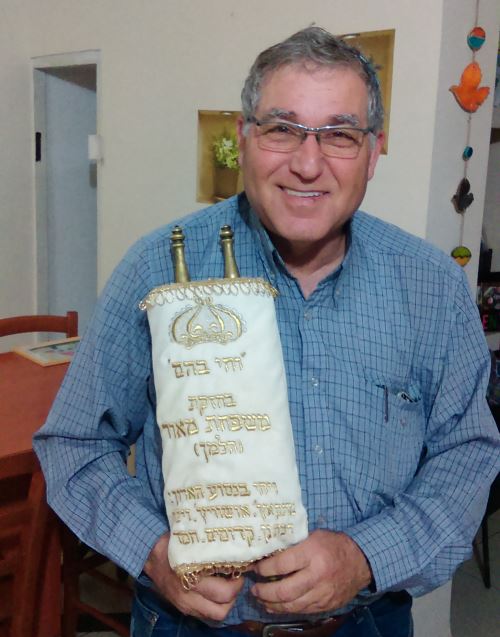
Yaakov Maor with the family Torah scroll smuggled into Auschwitz that he identified by its unusual copper staves.
Shlomo Rizel is a Chabad chasid who works for Radio Kol Hai in Israel and speaks on behalf of charitable organizations.
Translated by Esther Rabi.
© Copyright 2016, all rights reserved.
| ||
Story
| ||

G‑d descended upon Mount Sinai, to the top of the mountain. And G‑d called Moses to the top of the mountain, and Moses ascended. (19:20)
If G‑d descended from the supernal heights, couldn’t He come down just few thousand feet further? Why trouble a man of eighty to climb to the top of the mountain?
Yet therein lies the essential nature of man’s comprehension of Torah. G‑d is infinite and undefinable. Torah is His wisdom and will—by definition, ungraspable by the finite mind of man. The notion that the human intellect can relate to the divine truth, or even meet it halfway, is ludicrous. It is only because G‑d gave us the Torah, only because He chose to suspend the line He drew at creation separating the finite from the infinite, that we can access His communication to man.
But the Almighty desired that man’s understanding of Torah not be a gift from above, but the result of a combined effort, the issue of a union between the human mind and the mind of G‑d. Man must give it his intellectual all, and apply to the utmost the powers invested in his brain of flesh. And when he attains the peak of his finite mountain, there is G‑d with His gift of absolute truth.
—from the teachings of Chassidism
The Lubavitcher Rebbe, of righteous memory, related:
Rabbi Yechezkel Landau, the famed author of Noda B’Yehudah, served as the rabbi of Prague from 1754 to 1793. Once, a group of scholars who wished to contest his rabbinic qualifications presented him with a series of questions in Torah law. These fictitious “cases” were carefully constructed to be as complex and as misleading as possible, so as to ensnare the rabbi in their logical traps and embarrass him with an incorrect ruling.
Rabbi Yechezkel succeeded in resolving all the questions correctly—all, that is, but one. Immediately his detractors pounced on him, demonstrating how his verdict contradicts a certain principle of Torah law.
Said Rabbi Yechezkel: “I am certain that this case is not actually relevant, and that you have invented it in order to embarrass me. You see, whenever a man of flesh and blood is called upon to decide a matter of Torah law, we are confronted with a basic dilemma: how can the human mind possibly determine what is G‑d’s will? The dos and don’ts of Torah are the guidelines by which the Almighty desires that we order our lives. How is it that the finite and error-prone intellect is authorized to decide such divine absolutes?
“But the Torah itself instructs that the Torah ‘is not in heaven,’ but has been given to man to study and comprehend;1and that whenever a question or issue is raised, it is man, employing his finite knowledge and judgement, who must render a ruling. In other words, when a person puts aside all considerations of self and totally surrenders his mind to serve the Torah, G‑d guarantees that the result will be utterly consistent with His will.
“However,” concluded Rabbi Yechezkel, “this guarantee applies only to actual events, when a rabbi is called upon to determine what it is that G‑d desires to be done under a given set of circumstances; but not if his personal honor is the only issue at hand. Had you presented me with a relevant question, I know that I would not have erred, since I approached the matter with no interest or motive other than to serve the will of G‑d. But since your case was merely a hypothetical question designed to mislead me, my mind was just like every other mind, great and small alike—imperfect and manipulable.”
Yanki Tauber is content editor of Chabad.org.
Artwork by Sefira Ross, a freelance designer and illustrator whose original creations grace many Chabad.org pages. Residing in Seattle, Washington, her days are spent between multitasking illustrations and being a mom.
FOOTNOTES
© Copyright 2016, all rights reserved.
| ||
Focus on Special Needs
| ||
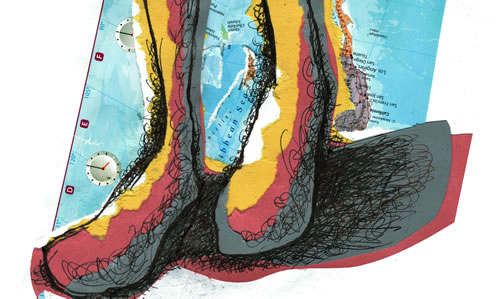
If the patients at Kingsbrook Hospital are Lenny’s siblings, you might say that I’m Lenny’s first cousin. Every Sunday for the past who knows how long, we schmooze, argue and banter while my sister Tova visits Molly, an older woman who is blind and lives down the hall.
Kingsbrook Hospital is where Lenny has lived since childhood. It’s his hospital-home. “You know, Chani, I’m here for always,” he says, neither sad nor mad about it. I intuit that his family chose Kingsbrook on his behalf when he was a young child. As the self-appointed “Prince of Kingsbrook,” Lenny carefully crafts his kingdom in present tense, ruling from Room 903. Lenny, the patient advocate. Synagogue sexton. Correspondence-course graduate. Man with paraplegia. “Hi, Lenny,” I say. “What’s new, besides for the usual lunacy?” he says. He always wants the undiluted answer. “Great question,” I counter. I’m still not ready to tell Lenny of my engagement. He might notice life passing him by while everyone else gets to waltz into happily ever after on two healthy legs. “Really nothing much, Lenny.” (I hope you don’t already know.) Lenny coughs. “Have you seen my latest?” A silversmith, Lenny empties a tiny bag of glittering jewelry onto his wheelchair tray. Every handcrafted piece on display speaks of the struggle and triumph living Lenny’s life. “This one.” I pick up a whimsical crystal charm attached to a thin silver chain. “I’ll pay you next week.” (After all, I do visit Kingsbrook every Sunday.) He waves at me. “Okay, you’re not running anywhere.” Next Sunday, I plunk down two $20 bills onto Lenny’s wheelchair tray. He is different today. “We need to talk, Chani.” “What happened, Lenny?” (Please, let it not be news of my engagement.) “It’s your engagement,” Lenny scowls. (Huh? Which idiot told Lenny? How utterly insensitive! I planned to do it with tact.) “Your sister told Molly. Duh.” “Lenny, it’s all very recent. I intended to tell you today. Lenny, I did plan to tell you today . . .” (But I didn’t think you’d celebrate too happily, what with your living in this depressing long-term care facility, and my walking off into the proverbial sunset and all.) “Whatever. I’ll remember to forget to tell you when I’m engaged. So is there a wedding date? And where’s the invitation?" “The wedding is on January 28th, and I’ll bring you an invitation next week.” (I’m floored! He plans on attending the wedding!) “Chani,” Lenny pauses, “I won’t be jealous of your problems. Don’t ever be jealous of mine.” That’s his way of settling the score. Lenny releases the brake of his wheelchair. “Walk with me,” he commands. We amble down the hall. Lenny approves of my wedding invitation. I tell him I would understand if he couldn’t make it. The weather’s been awful, and the first part of my wedding ceremony—the chupah—will take place outdoors. But Lenny is undeterred. “Kingsbrook ambulette can bring me inside the hall, and I’ll see you all after the chupah.” “Are you sure, Lenny?” (Yikes, he can’t be serious. I know he doesn’t leave Kingsbrook very often.) “For someone who’s getting married in four weeks, you’ve still got plenty growing up to do, Chani.” “Congrats!” Lenny beams. Lenny wears his black bowtie and spiffy jacket with flair. “I am honored by your presence, Lenny.” (You are a gift. You teach me what it’s like to live your best life—excruciating challenges notwithstanding.) Lenny smiles approvingly. “Great ambiance. Oh, and mazal tov.” I visit Lenny one last time before my big move to Toronto. “Chani, the wedding was superb. Can’t say I loved the chicken, but everything else was perfect.” I wait, sensing more. I know he’s been considering surgery. “Listen, I’ve decided to go ahead with the surgery. It’s complicated and the doctors are cautious, but I’ll be okay. Walk with me.” We make our way to the nurse’s station. Dorothy in 804 desperately requires a geriatric ophthalmologist, and Lenny threatens legal action, along with “Don’t give me that long holiday weekend nonsense. Figure it out, ladies!” “Lenny, I hate goodbyes.” (I feel like your bags are packed, too.) “Then let’s skip that part.” I say nothing. “Promise me that I will be remembered as someone who made a difference. You know I was here for all of them; you saw. This was my journey. And now you’re off on your own journey.” “Yes, Lenny.” (I will cry. Later.) “So, hop to it.” 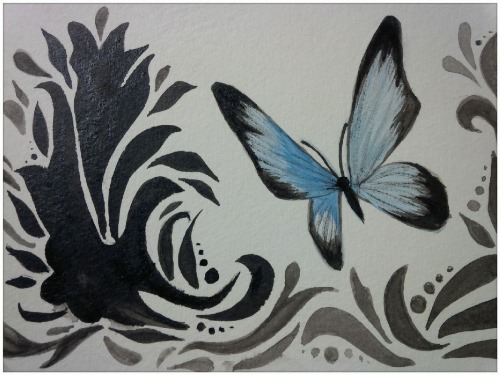
This painting was created by Charna Brocha Perman, the author's daughter.
Lenny’s stride quickens. Past the narrow, stuffy halls of Kingsbrook Hospital, past the patients he adored, past the disobeying nurses and nosy visitors, past the doting friends and buddies, Lenny walks—this time alone—to a new place. Lenny no longer commands, “Walk with me.” But I hear his voice, still insistent. “Keep on walking, Chani!” And with sometimes faltering, sometimes fierce footsteps, I blaze my own trail. Lenny’s yahrtzeit (date of passing) is on the 28th day of the Jewish month of Shevat. Please do a mitzvah (good deed) in honor of Yehudah Leib ben Shlomo, and share your mitzvah with me in the comments section below.
Chana holds a master’s degree in special education, and has been in the field of education for twenty-five years. Her cherished roles as Jewish woman, mother and Learning Strategies instructor provide inspiration and material for writing at every turn. As a longtime volunteer with the Friendship Circle, Chana was recognized by the Ontario legislature for “bringing a smile to the faces of children with special needs.”
The Ruderman-Chabad Inclusion Initiative (RCII) is dedicated to building on the philosophy and mission of Chabad-Lubavitch by providing Chabad communities around the globe the education and resources they need to advance inclusion of people with disabilities. RCII engages Chabad’s network of human and educational resources to create a Culture of Inclusion so that all Jews feel welcomed, supported and valued throughout their entire lifecycle.
Artwork by Sarah Kranz.
© Copyright 2016, all rights reserved.
| ||
Focus on Special Needs
| ||
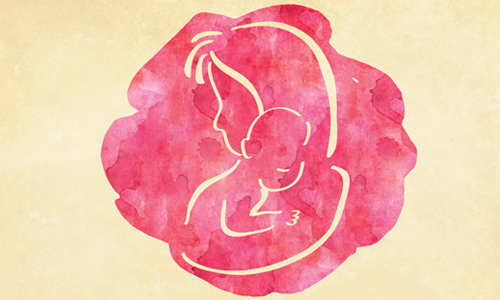 Question:After our daughter was born, my husband and I didn’t have children for 10 long years. Then we were finally blessed with a beautiful boy. I had big plans for him. He was going to be a doctor, maybe a rabbi, maybe both. He was going to marry a lovely Jewish girl and give me many beautiful grandchildren.Well, my plan is not working out. I had big plans for himMy son, now five years old, was diagnosed with severe autism a year ago. He is five years old and nonverbal. He is five years old and cannot dress himself. He is five years old and uses diapers around the clock. He is five years old and cannot communicate with signs or pictures, as it is all too complicated for him. He communicates by screaming or crying or kicking or grabbing what he wants. I am infinitely sad. He will never get married and have children, let alone be a doctor or rabbi. My dream of having nachat (pride) from my son is shattered. Do you have any wisdom to share with a broken and exhausted mother? Answer:I read your words and I can hear the anguish in your voice. Even if I can find some wisdom to share, it may not be able to counter that anguish. Intellect does not always speak to emotion.But I am sure you have moments when you stand a little apart from that anguish, and at those moments you can gain perspective. It is toward this perspective that I will try to contribute. Your son was entrusted to you, Intellect does not always speak to emotionand specifically to you. G‑d knew exactly what He was doing when He chose you to be this boy’s mother. It’s not a punishment—it’s a blessing. But that doesn’t mean it’s easy. Children are not given to us to be ours. They are our responsibility, not our property. Our job is to provide for their spiritual, emotional and physical needs to the best of our ability. What we receive in return are beautiful and profound gifts. These gifts can come in several forms. And not always are the gifts what we expected. Some children give the gift of nachat. When our children excel at school, in their professions, in their relationships and in their contributions to the world, it reflects on us, and we gain deep satisfaction from them. But some children do not give that sort of nachat. They don’t accomplish the milestones and cannot achieve the successes reached by others. These children give us something else entirely. They shift our paradigms. They teach us new ways of loving and giving. They push our limits and extend our horizons. They demand from us a more unconditional and altruistic type of love. And they give us a gift that is more precious and hard-earned than nachat. They give us depth. Your dear son has presented you with a challenge, one that you did not ask for: to redefine what it means to be a mother, what it means to have a child, what it means to love, and indeed what it means to live in this world. Are we here to enjoy, or are we here to toil? Is pleasure the most important thing, or is meaning and purpose? What counts more, what I receive or what I contribute? Am I here just for me, or am I here to serve? You have the power to answer these questions, by being the mother that only you can be to your son. I am not saying you are lucky. I am not saying I envy you. I am not saying you have nothing to complain about. I am saying that you have a choice. You can allow your disappointment and sorrow to eat you up, erode your marriage, sideline your healthy daughter and breed more resentment toward your son. You will be justified in doing this. No one can blame you. And no one will gain anything. Or you can choose to look deeply You have a choiceat yourself and say: I am up to this. I am going to be the mother that G‑d wants me to be. There will be moments of heartache and a lot of hard work. But this is my life. Maybe not the life I expected, but the life expected of me. Doctors and rabbis can do a lot of good. But there is nothing more powerful than the good that can come to the world through the innocent soul of a boy, and the mother who loves him unconditionally. I wish you strength and blessing.
Aron Moss is rabbi of the Nefesh Community in Sydney, Australia, and is a frequent contributor to Chabad.org.
Artwork by Sefira Ross, a freelance designer and illustrator whose original creations grace many Chabad.org pages. Residing in Seattle, Washington, her days are spent between multitasking illustrations and being a mom.
© Copyright 2016, all rights reserved.
| ||
Women
| ||
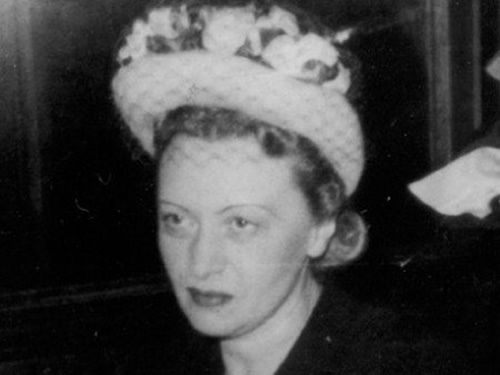
On the 22nd of Shevat 1988, the Rebbe’s wife of sixty years, Rebbetzin Chaya Mushka Schneerson, passed away.1
Unlike her husband, Rebbetzin Chaya Mushka did not practice her dedication to the Jewish people in the public eye, but in the privacy of her own home. She never attended her husband’s public talks or communal services in the main synagogue. Even on Rosh Hashanah, the Rebbe blew the shofar for her at home, and she always referred to herself as Mrs. Schneerson, never as “Rebbetzin.”2 Before her husband accepted the leadership of Chabad-Lubavitch, she had not been so retiring. She attended community events and celebrations, and during the public talks of her increasingly frail father, Rabbi Yosef Yitzchak, she stood at the door to ensure the room did not become overcrowded.3 When her father passed away, and the future of the movement hung in the balance, she told her husband, “If you do not become rebbe, thirty years of my father’s life will have gone to waste.”4Rebbetzin Chaya Mushka did not practice her dedication to the Jewish people in the public eye, but in the privacy of her own home. The strong stance that she took speaks volumes of her courageous commitment to Chabad’s continuity. Her older sister had long anticipated that her own husband, Rabbi Shmaryahu Gourary, would become the next rebbe. The Rebbetzin had no desire to compete with her sister, but along with the chassidim she understood that only an individual of her husband’s visionary stature could continue her father’s mission.5 The Rebbetzin’s sensitivity towards her sister seems to have been one of the factors that led her to evade any public occasion where she might be honored as the Rebbe’s wife.6 These tensions came to the fore in 1985, when it was discovered that the Gourarys’ son Barry was sneaking rare books from his grandfather’s library and selling them. When confronted, his mother claimed the books as family property, which her son had every right to sell for profit. Chabad’s central organization contested this claim, arguing that the books were the collective property of the Chabad community.7 Barry Gourary’s lawyers insisted on fighting the case in federal court, and served Rebbetzin Chaya Mushka with a deposition. When asked to whom she thought the books belonged, she replied, “I think they belonged to the chassidim, because my father belonged to the chassidim.” Labeled “the most dramatic moment in the whole proceeding” by Chabad’s lawyer, this remark poignantly expressed just how much the Rebbetzin gave up to ensure that chassidim would continue to have a rebbe.8 The Rebbetzin had no public profile, but did have a busy social life. She befriended many individuals, from within the Chabad community and from other backgrounds, entertaining them in her home, playing with their children, writing to them and conversing by telephone.9 In 1974, Israeli student Orah Jurawel visited New York and brought a gift for the Rebbetzin from a mutual friend. “When I arrived in New York, I called her and she immediately invited me to her home. . . . The Rebbetzin, a small, thin lady, was dressed very elegantly. She escorted me into the dining room, where the table was set with refreshments and beautiful tableware. She was very interested in what I was doing, what I was studying, what my aspirations were.” The Rebbetzin was not simply being polite. “You could understand why they were husband and wife. And if the Rebbe had one admirer, one chassid in this world all those years, it was her.”This was the beginning of a lasting connection. When Jurawel’s fourth child was diagnosed with Down syndrome and heart complications, the Rebbetzin called to encourage her. “Everyone else asked about the child and the doctors, but the Rebbetzin always asked how I was feeling. . . . Her message was simply that I too am important . . .”10 Jurawel’s relationship with the Rebbetzin was certainly special, but those who knew the Rebbetzin testify that it typifies the intelligence, enthusiasm and concern that characterized all her interactions.11 By drawing a sharp line between her private persona and the public realm, the Rebbetzin was able to devote herself unreservedly to her husband. The Rebbe worked unthinkably long hours and never took a day off. But during the time he was at home, no one dared intrude. At whatever unearthly hour he arrived, the Rebbetzin was always awake to receive him.12 Visitors to her home often noted the piles of books, newspapers and journals that the Rebbetzin scoured for developments in science, global affairs and politics that the Rebbe might be interested in.13 Dr. Ira Weiss, the Rebbe’s cardiologist, spoke to the Rebbetzin almost daily to receive her report on the Rebbe’s health situation, and was one of the few people to interact with them in the privacy of their home. Weiss testified to the deep love, concern and respect that they each showed towards one another,14 and remarked that she was the one person in the world who the Rebbe could look to for honest critique: “I was once at dinner with the Rebbetzin and the Rebbe. I had a chance to see them in action together, and it was a very good exchange, because the Rebbetzin was very smart. . . . Here was a personal conversation, the Rebbe and Rebbetzin talking to each other at the table and having a little bit of intellectual sparring. It was charming and revealing.”15 According to Rabbi Yehuda Krinsky, the Rebbe’s longtime secretary, the Rebbetzin’s unique relationship with her husband enabled her to appreciate his qualities in an entirely different way: “You could understand why they were husband and wife. And if the Rebbe had one admirer, one chassid in this world all those years, it was her.”16
Eli Rubin is a writer and researcher. He is chiefly interested in chassidic thought and history, rationalism and mysticism, as well as general Jewish studies.
FOOTNOTES
2.
Interview with Rabbi Shmuel Lew, November 30, 2011. See also The Rebbetzin, a film by JEM Media.
4.
Testimony of Rabbi Yosef Wineberg, cited in Telushkin,Rebbe, page 367.
5.
For more on the events leading up to the Rebbe’s reluctant acceptance of the leadership, despite concern for his brother-in-law’s position, see The Seventh Generation: A Leader of Leaders.
6.
Interview with Rabbi Shmuel Lew, November 30, 2011.
7.
For more details about this case see Telushkin, ibid., pp. 385–410.
12.
Testimony of Carlebach, cited above, note 3.
15.
Mrs. Baila Olidort, interview with Dr. Ira Weiss, first published on Lubavitch.com.
© Copyright 2016, all rights reserved.
| ||
Women
| ||

As a mother, there are oh so many things to worry about. Does my son have friends? Is he being bullied? Is he bullying? Is he reading at grade level? Will he turn out all right? These small anxieties can really add up. . . . How do I process these thoughts so they don’t put me on edge?
My father used to repeat the story of a poor old man traveling on the side of the road with a package half his height and double his weight. When a rich man passes in a coach and offers him a lift, he gratefully accepts it. To the rich man’s surprise, he notices that while the poor man is seated in his coach, he is still carrying the heavy load! The poor man explains, “It’s bad enough that I am troubling you to give me a lift, but I should also ask you to carry the weight of my package for me?” The rich man responds, “The fact that you are in my carriage means that I am carrying both you and your package—what needless energy you are wasting!” I recently read a letter of the Rebbe underscoring the same point: You are, without a doubt, a believer. So, the very first point of belief is that G‑d directs the world. And if He is capable of directing 1.5 billion people, then your own affairs will certainly see the fulfillment of the verse, “I have made you and I will carry you; I will sustain you and deliver you” . . . Is G‑d really in need of your worrying as to how He is going to run your affairs and solve your problems? Or will He succeed in finding good solutions even without your worrying?And that’s really the only solution to my anxiety—knowing that my worrying will not help with the outcome. Thoughtstream: Today, I will put down my load and enjoy the ride. (Adapted from Igrot Kodesh, vol. 4, p. 255.)
Sara Blau is a teacher and extracurricular director at Beth Rivkah High School. She is a mother of two children and the author of several children“s books.
Artwork by Sefira Ross, a freelance designer and illustrator whose original creations grace many Chabad.org pages. Residing in Seattle, Washington, her days are spent between multitasking illustrations and being a mom.
© Copyright 2016, all rights reserved.
| ||
Women
| ||

I may live in a city where there is not much greenery to be had, but at least I have my tree. It grows right in front of my building, its shady branches sweeping over the fire escape, thrusting their leaves into my bedroom window for a friendly wave.
Trees and urban areas don’t get along very well. Their roots rip up sidewalks and get entangled in sewer pipes. Their branches must be trimmed regularly lest they poke into power lines or apartment windows. Indeed, their uneasy coexistence exemplifies our own complicated relationship with the natural world. I live in a neighborhood with a synagogue on every street corner. Still, I have a spiritual hunger that can be assuaged only by contact with nature. It’s no wonder that the chassidic movement has its roots in the Eastern European countryside. The surroundings—the dense forests and quiet meadows—lent themselves to hours of spiritual meditation. On the other hand, chapter six of Tanya describes the physical world as “a world filled with impurity and unholiness . . . and therefore all affairs of this world are difficult and evil, and the wicked prevail.” It seems that the physical world can come in two forms. One that brings us closer to G‑d, and one that pushes G‑d away. In which do we live? Cities are a monument to human endeavor and creativity. They are places where art, culture and education can flourish. But they are also places where the worst of human tendencies—greed, jealousy, arrogance—are on full display. And in this manmade world, G‑d can be a bit harder to find. I remember visiting the amusement park as a child, and right in midst of the wild rides and attractions I’d look for a little patch of grass. I would sit and watch the birds pecking in the dirt and the ants scurrying about. Many adults don’t realize that for a child an amusement park can be a very stressful place, full of harsh noises, strange people, wild movements. That square of grass was mine; it represented security, serenity and stability. I could enjoy that little part of nature without having to push anyone else aside, without an interminable wait for my turn. Life in the city sometimes feels like a perpetual carnival, with endless noise and distractions; aggressive, pushy crowds—and I’m just seeking my little patch of dirt. Somewhere above, G‑d is looking on, amused by our antics. “He who dwells in heaven laughs . . .”1 But He entrusted His wonderful, endlessly creative world into our hands. He gave us the tools to enrich it, develop it or make an utter muck out of it. On the third day of creation, G‑d first gathered the waters together to allow dry land to be seen, and then created trees and all vegetation: “Let the earth sprout vegetation, seed yielding herbs, and fruit trees producing fruit according to its kind, in which its seed is found on the earth.”2 When the day’s work was completed, G‑d said, “And it was good,” twice. G‑d’s creative power—symbolized by the reproductive potential within trees—can be expressed in two ways: First, there are trees and grasses that grow in the wild. Their growth is a linear process: the wind blows and disperses the seeds, or animals eat the fruit and carry the seeds to distant locations. Then there is vegetation cultivated by the human hand. We figure out the best seasons for planting, the best way to fertilize and tend to the crops to ensure the greatest yield. We take G‑d’s initial investment and multiply it a thousandfold. This is why, on the sixth day, when G‑d created man, He said, “And it was very good.” Like all of creation, we have the ability to procreate, to produce progeny “in our own kind.” But unlike all other creatures, we were given additional intellectual powers to unravel the secrets of creation—to harness the inherent powers of nature for our own purposes. Our initial agricultural endeavors gave rise to human culture and civilization. But they also gave rise to some of the less pleasurable aspects of human life: inequality, greed, spread of disease.3 And this is the duality we struggle with until today: the very control over nature that G‑d handed to us can be a source of tremendous blessing or the opposite, G‑d forbid. My way of handling city dwellers’ angst is to get in touch with a tree. Trees keep us grounded in the true reality so that we don’t get shaken by the confusion that surrounds us. And we need to reach out to the figurative “tree” as well—the Torah, our G‑d-given source of guidance and direction. “It is a tree of life to all those who hold on to it, and those who support it are blessed.”4 (Based on an address by the Lubavitcher Rebbe, 11 Nissan 5740.)
Artwork by Sefira Ross, a freelance designer and illustrator whose original creations grace many Chabad.org pages. Residing in Seattle, Washington, her days are spent between multitasking illustrations and being a mom.
FOOTNOTES
3.
Jared Diamond, “The Worst Mistake in the History of the Human Race,” Discover Magazine, May 1987.
© Copyright 2016, all rights reserved.
| ||
Parshah
| ||

On my first trip to Israel in 1978, my traveling companion wanted to climb Mount Sinai. It seemed like a fun Jewish adventure, so I went with her. I remember waking up way too early, that it was way too hot, and that the guide kept talking about Moses. What I remember now, so many years later, is that most everything he said went in one ear and out the other.
I often wonder: what message was playing so loudly that I couldn’t hear that G‑d gave the Torah to the entire Jewish nation on Mount Sinai? (I have since learned that we actually don’t know where the real Mount Sinai is, but I don’t think that was the problem.)The guide kept talking about Moses I’m fairly sure that the guide related the Sinai story pretty much like that—a story—but I am definitely sure that hearing it didn’t even raise a question in my mind about what it meant to be Jewish, other than being smart, funny and persecuted. Clearly, it would have taken much more than a day trip up any mountain to free my head of all the information that had nothing to do with G‑d and Torah. I was a pop-culture sponge, and my mind was packed with tidbits of trivia, much of it from my favorite childhood pastime: watching television. Cartoons, sitcoms, soap operas; nothing was too dumb. Watching TV was what Americans did,and I did it exceedingly well. But, nine years later, when I was ready to listen and decided that I wanted to become observant, it was challenging not to be frustrated, even saddened, by the amount of pop-culture “stuff” that had hoarded precious storage space in my brain, never to be emptied. Instead of learning which way to turn during the Amidah prayer, I had been watching The Beverly Hillbillies. I can still remember the names of all the cast members, but when I go to the synagogue, I often need help. This brings me to this week’s Torah portion, and what I learned from that television series in particular. The show’s creators probably didn’t intend to make the connection, but one of the main characters on The Beverly Hillbillies was named Jethro, which is also the English translation of the name of this week’s Parshah, Yitro. Which means that year after year, whether I like it or not, when it’s Parshat Yitro, that show’s theme song plays in my head. This Torah-television connection may seem ironic, especially because Parshat Yitro contains the pivotal event for the Jewish people and the entire world—the moment when G‑d gave the Torah on Mount Sinai. But it Everything has the potential to be transformedmakes sense in light of the original Jethro/Yitro’s identity. He was Moses’ father-in-law, a Midianite priest who enjoyed tremendous status and high regard in the world, largely for his unparalleled expertise in the field of idol worship. When a maven like Jethro recognized that this G‑d was the One and Only, then chose to convert to follow Him, it sent a powerful spiritual message to the world for all time: Everything about a person, including the past, has the potential to be transformed into holiness. That’s why this magnificent Parshah is named after a convert who once served as an idolatrous priest. And for me, that message is a priceless gift, although it took many years for me to be grateful for my history. Who knows what part the emptiness of entertainment played in igniting my desire for a life of meaning? The knowledge that my current effort in the realm of G‑dliness actually elevates my past is a great joy for me—one that allows me to laugh a little more about the things that feel like they will stay in my head forever.
Lieba Rudolph lives in Pittsburgh, PA, and writes a weekly blog about Jewish spirituality.
Artwork by Sefira Ross, a freelance designer and illustrator whose original creations grace many Chabad.org pages. Residing in Seattle, Washington, her days are spent between multitasking illustrations and being a mom.
© Copyright 2016, all rights reserved.
| ||
Parshah
| ||

A husband and wife came to the rabbi for guidance on resolving their different parenting styles. The wife began: “Isn’t it important to establish rules and regulations, so that kids will know what is expected of them?” “That’s true,” said the rabbi. The husband continued, “Aren’t rules rigid? It’s important that we show our children how much we love them—right?” “That’s true,” nodded the rabbi. Frustrated, the wife responded, “How can what I said be true, and what he said be true as well?” “That’s true, too,” concluded the rabbi.
In this week’s Torah portion, G‑d tells Moses, “So shall you say to the house of Jacob, and tell the sons of Israel.” The verse appears to be redundant. If Moses is told to address the “house of Jacob,” is that not the same thing as talking to the “sons of Israel”? Rashi’s interpretation is well-known: “The house of Jacob” refers to the women, while the “sons of Israel” is a reference to the men. Moses is advised to talk to the women softly, as indicated by the Hebrew termtomar, “say.” The men, on the other hand, are to be addressed strictly, as is evident from the stronger word tagid—“tell.” Rabbi Chaim ibn Attar,1 an 18th-century biblical commentator and kabbalist, provides a unique interpretation. He explains that on a deeper level, the verse in its entirety is indicating how Moses should address all the Jewish people, irrespective of their gender. In general, there are two ways of serving G‑d; each has its advantages and disadvantages. The first level is one who serves G‑d out of fear, like a servant who stands in complete submission to his master. Understandably, this is not considered the optimum level. A higher level is a person whose commitment to G‑d stems from love, much like a child who adores his parent. Yet this level of intimacy may lead such an individual to become “too comfortable” with G‑d, which might lead to a lapse in his uncompromising obedience. “Jacob,” which means “heel,”2 alludes to a Jew who is in on a lesser spiritual level, whose service of G‑d stems from fear. “Israel,” whose letters can be rearranged to spell li rosh, “to me is the head,” is the name that Jacob was given after having prevailed over Esau. This symbolizes the Jew whose relationship with G‑d is greater because it is inspired by love. In truth, both love and awe are necessary ingredients to develop a holistic relationship with G‑d. Therefore, G‑d tells Moses to address the Jewish people in a manner that is both loving and awe-inspiring at the same time. Hence, the terms tomar, which denotes softness, and tagid, which implies strictness. To find balance, each Jew has to reflect upon how he or she naturally serves G‑d, and then make sure to incorporate the opposite characteristic. The “Jacob Jew,” who serves G‑d based on awe, has to temper it with tomar, a generous dose of love. While the “Israel Jew,” who serves G‑d out of love, is advised to cultivate some tagid, a good measure of reverence. The next verse begins with the words, “You saw that which I did to Egypt.” These words provide a deep meditation to simultaneously arouse feelings of awe and love of G‑d. When one contemplates the punishments that G‑d meted out to the Egyptians, he will come to develop a sense of awe, inspired by the unbelievable miracles and supernatural acts, that G‑d initiated. Eventually, his heart will be stirred by love, when he comes to the realization that G‑d turned over heaven and earth because of His profound love for His people. The verse concludes with the words, “I carried you on eagle’s wings and brought you close to Me.” G‑d elaborates on His feelings of love for the Jewish people, using the powerful imagery of an eagle doting on her fledglings. This indicates that although both awe and love are important, ultimately, serving G‑d out of love takes precedence.3. The giving of the Torah—the cosmic marriage between G‑d and the Jewish people—offers us insight into marriage here on earth. The Talmud teaches us that a husband should love his wife as much as himself—and respect her more than himself.4 Find a happy, newly married couple, and you’ll see two people who are totally in awe of one another and treat each other with the utmost respect. Yet, after a while, the initial admiration is replaced by adoration, a healthy familiarity and closeness. Although the love is much greater and richer, it also has a downside. “Surely, she’ll forgive my grouchy mood and missing smile.” “And if I’m ever abrupt, he’ll take it in stride in the name of love.” “So shall you say to the house of Jacob, and tell the sons of Israel”: A balanced relationship needs both. So if you find yourself turning into “Israel,” you’ve got to rebound to “Jacob.” And once you are back to “Jacob,” remember that “Israel” is most important, after all. It is the tension between the two that provides the framework of a beautiful relationship. This concept holds true for any number of relationships, from parenting to educating. It’s a tricky balance of discipline and love, but ultimately, it’s the love that is most important!
Chana Slavaticki has been an educator for over a decade, and lectures at various adult education institutes and Chabad centers. She lives in Baltimore, Maryland, with her husband and three children.
Artwork by Sefira Ross, a freelance designer and illustrator whose original creations grace many Chabad.org pages. Residing in Seattle, Washington, her days are spent between multitasking illustrations and being a mom.
FOOTNOTES
1.
Ohr Hachayim to Exodus 19:3.
2.
Jacob was given this name because when he was born he was holding on to the heel of his brother Esau.
3.
Ohr Hachayim, ibid. 19:4.
4.
Talmud, Yevamot 62b.
© Copyright 2016, all rights reserved.
| ||
Parshah
| ||
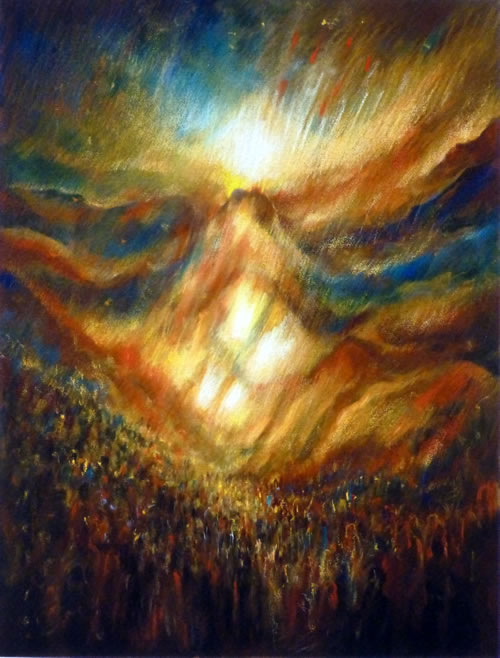
And the entire Mount Sinai smoked because the L-rd had descended upon it in fire...And all the people saw the voices and the torches, the sound of the shofar, and the smoking mountain, and the people saw and trembled; so they stood from afar. (Exodus 19:18 and 20:15)
As the people gathered around Mount Sinai, a heavenly supernal light settled on top of the mountain. Here in the painting the sky radiates into shades of yellow and blue, illuminating the mountain and the multitudes of people below. Our sages tell us that in its original form, the Torah was composed of fire, and it was from within fire that the Torah was revealed—on a mountain that was ablaze. Here in the painting the mountain glows white hot, incandescent and luminous. Every day, we are told a Heavenly Voice issues from Sinai urging us to recall how G‑d speaks to us from within the fire.
Yoram Raanan takes inspiration from living in Israel, where he can fully explore and express his Jewish consciousness. The light, the air, the spirit of the people and the land energize and inspire him. His paintings include modern Jewish expressionism with a wide range of subjects ranging from abstract to landscape, biblical and Judaic.
© Copyright 2016, all rights reserved.
|

---------------------
VIDEO

Explore the Aleinu Prayer
The final class in the series
By Shmuel Kaplan
 Watch (29:43)
Watch (29:43)
<script language="javascript" type="text/javascript" src="http://embed.chabad.org/multimedia/mediaplayer/embedded/embed.js.asp?aid=3187342&width=auto&height=auto"></script><span style="clear:both;" class="lb" id="lbdiv">Visit <a href="http://www.chabad.org/multimedia/default_cdo/aid/591213/jewish/Video.htm">Jewish.TV</a> for more <a href="http://www.chabad.org/multimedia/default_cdo/aid/591213/jewish/Video.htm">Jewish videos</a>.</span>

The Rebbe’s Plan to Help New York’s Criminals
Historic recordings from the archives
 Watch (6:04)
Watch (6:04)
http://www.chabad.org/therebbe/livingtorah/player_cdo/aid/3177279/jewish/The-Rebbes-Plan-to-Help-New-Yorks-Criminals.htm
http://www.chabad.org/3177279

ALS Took My Husband But Not My Faith
The three powers that the Jewish woman has been given help us to overcome our greatest challenges and adversaries.
By Deecla Katz
 Watch (13:25)
Watch (13:25)
<script language="javascript" type="text/javascript" src="http://embed.chabad.org/multimedia/mediaplayer/embedded/embed.js.asp?aid=3143697&width=auto&height=auto"></script><span style="clear:both;" class="lb" id="lbdiv">Visit <a href="http://www.chabad.org/multimedia/default_cdo/aid/591213/jewish/Video.htm">Jewish.TV</a> for more <a href="http://www.chabad.org/multimedia/default_cdo/aid/591213/jewish/Video.htm">Jewish videos</a>.</span>
---------------------
Lifestyle
| ||
This Monday, Jews around the world will celebrate the 15th of Shevat, the New Year for the trees. Traditionally we celebrate by eating fruit, specifically the seven fruits of Israel, including grapes, figs, pomegranates, olives and dates.
Of course you can eat the fruit plain, but you can also have fun with it—like I did when I made this two-toned chocolate bark with fruit and nuts. It’s easy, delicious and eye-catching. Best of all, you can easily adjust it to suit your taste—just use whichever fruit and nuts you enjoy eating. 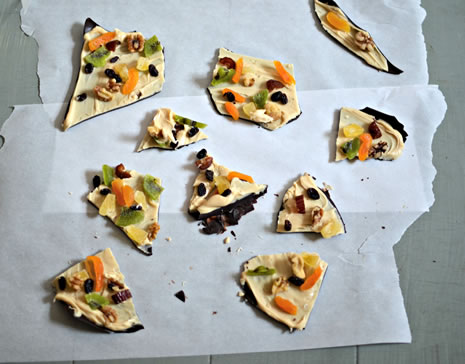 For Tu B’Shevat, you can use figs, dates, raisins and pomegranate seeds (fresh or dried). You can also use any other dried fruit, nuts and seeds. As you can see, I used a variety.  In terms of chocolate, it’s important to use good quality chocolate. The type you would eat, not baking chocolate. The best way to melt it is over a double boiler. You can make one yourself with a small pot and a bowl, like this:  Place the chocolate in the bowl and about an inch of water in the pot. Put the pot over the fire and the bowl over the pot. As the water heats, the steam will gently melt the chocolate. Then follow the assembly instructions below, and enjoy! 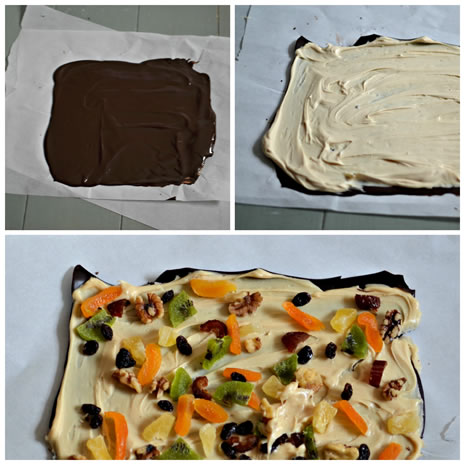 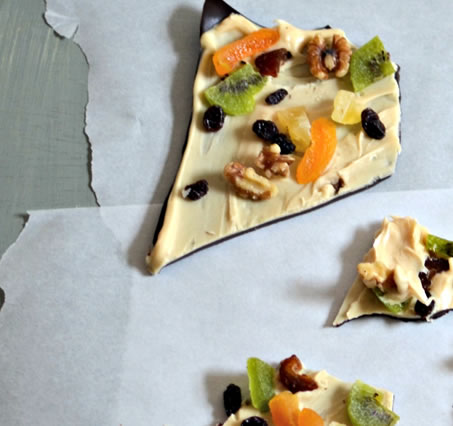 Ingredients:
Directions:
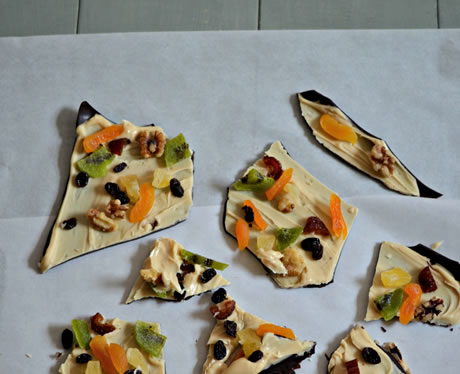
Miriam Szokovski is the author of the historical novel Exiled Down Under, and a member of the Chabad.org editorial team. She enjoys tinkering with recipes, and teaches cooking classes to young children. Miriam shares her love of cooking, baking and food photography on Chabad.org’s food blog, Cook It Kosher, and in the N’shei Chabad Newsletter.
© Copyright 2016, all rights reserved.
| ||
Question
| ||
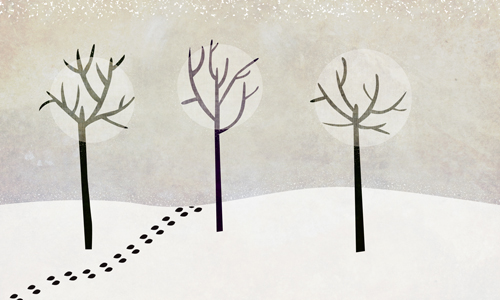 Question:I just got an e‑mail about celebrating the New Year for Trees in January. I don’t know about where you live, but where I live, it’s freezing, with plenty of snow covering the trees. If you want to celebrate the trees, do it in spring. Why now, right in the middle of winter?Reply:The 15th day of the Jewish month of Shevat—or Tu B’Shevat, as it is commonly called—is not the Jewish version of Arbor Day, but is considered the “New Year for Trees,” with real implications for Jewish law. The 15th of Shevat serves to separate one year from the next with regard to the laws of maaserot (tithes of produce), orlah (the fruits of the first three years, which are forbidden for consumption) and sheviit (Shemittah, the Sabbatical year).For example, the law of orlah is that the fruit of a tree may not be eaten during the first three years after its planting. The fruits of the fourth year are called neta reva’i, and are sanctified; they must be eaten in Jerusalem or “redeemed” with money.1 From the fifth year on, the fruits may be consumed in the normal manner.2 But how do we calculate when the tree has turned three and then four? From Tu B’Shevat. Practically, this means that the fruit that grows after 15 Shevat of year four may be eaten in Jerusalem, and those grown after 15 Shevat of year five can be eaten at home.3 Why was this date chosen?As is the case with many Torah laws, the halachah is based on what happens in the Land of Israel.4 So, since most of Israel’s rainy season is over by the 15th of Shevat, this date is considered the New Year for Trees.5 Rabbi Shlomo Yitzchaki (Rashi) explains that at this point the ground has become saturated with the rains of the new year, causing the sap to start rising in the trees, which means that the fruit can begin to bud.The Jerusalem Talmud records an alternative explanation. Until the New Year for Trees, all trees can survive on the water from the previous year. After their New Year, the trees derive their life source from the water of the new year.6 Light at the End of the TunnelIf you are reading this in sub-zero weather, you may find the most comfort in the explanation of Rabbi Menachem Meiri (1249–c. 1310), who points out that the winter season extends from the month of Tevet until the month of Nissan. The 15th of Shevat is the midpoint between fall and spring. Once half the winter has passed, its strength is weakened, the cold is not as intense, and the budding process begins.7So take heart. Yes, it may be smack in the middle of winter, but the 15th of Shevat marks a turning point, a time when under all that cold and snow the sap of the trees is rising, readying for spring. In a sense, the 15th of Shevat signifies that sometimes it is precisely from within the darkest and coldest moments of our lives that the new blossoms burst forth!
Rabbi Yehuda Shurpin responds to questions for Chabad.org's Ask the Rabbi service.
Illustration de Sefira Ross, une designer et illustratrice freelance dont les créations originales ornent de nombreuses pages de Chabad.org. Résidant à Seattle, Washington, elle partage son temps entre ses créations graphiques et être une maman.
FOOTNOTES
1.
The fruits of the fourth year can be eaten only when the Holy Temple is standing, by someone who is ritually pure. Unfortunately, today we do not have the Temple (a state of affairs we constantly plead with G‑d to change), and we are all considered ritually impure and do not have the means necessary for purification. Therefore, instead of bringing these fruits to Jerusalem, we “transfer” their holiness to (a small amount of) money, and we discard that money. See Shulchan Aruch, Yoreh De’ah 294:6.
2.
The “years,” however, are not necessarily full years.
The count works like this: No matter how the tree started growing, whether through planting or grafting, the age of a tree is determined by when it was planted in relation to Rosh Hashanah. If it was planted by the 15th of Av (one and a half months before Rosh Hashanah), then it will be counted as one year old when it reaches that Rosh Hashanah. If, however, it was planted from the 16th of Av and onward, it is counted as being one year old only on the Rosh Hashanah of the following year. (Talmud, Rosh Hashanah 9b–10a; Mishneh Torah, Hilchot Maaser Sheni 9:10–12). However, although Rosh Hashanah is the New Year for saplings, Tu B’Shevat is the New Year for trees. So the sapling becomes a tree (on Rosh Hashanah), but does not “age” as a tree for the purposes of orlahuntil Tu B’Shevat.
3.
Rashi on Talmud, Rosh Hashanah 10a.
4.
We start mentioning rain in the Amidah prayer on Sukkot based on the Land of Israel, and the Talmud tells us that G‑d allocated the best rains to Israel first, with the rest of the world getting the “leftovers” (Talmud, Taanit 10a).
5.
Talmud, Rosh Hashanah 14a and Rashi ad loc. See also Jerusalem Talmud, Rosh Hashanah 1:2.
6.
Jerusalem Talmud, Rosh Hashanah 1:2. See Pnei Moshe ad loc.
7.
Beit HaBechirah, Rosh Hashanah 1:1.
© Copyright 2016, all rights reserved.
| ||
Jewish News
| ||
Small places tend to be big on word of mouth. That’s especially true in Israel, and even more so in Tel Aviv, which for all its international glam is really comprised of lots of little neighborhoods with close-knit communities.
One of them is made up of native English-speaking young professionals and new olim (“immigrants”)—a significant number from the United States, Canada, Australia and South Africa—who have settled in the city that serves as Israel’s economic and social hub. In the past, this group has sometimes fallen under the radar of established Israeli life, particularly when it came to religious programs and services, but no longer. Chabad on the Coast, co-directed by Rabbi Eliyahu (“Eli”) and Shterna Sara Naiditch, was started right before the High Holidays to serve this population, including English-speaking lone soldiers—volunteers from abroad who serve in the Israel Defense Forces and have no family in the country. The couple and their two young children live in an apartment near the stretch of beachfront hotels on Hayarkon Street and have been very busy of late catering to a growing crowd of participants, including vacationers. The rabbi eagerly answered questions about their presence there. Q: Why the need now for Chabad in this very touristy area of Tel Aviv? A: People were asking for something along religious lines; they said they couldn’t find programs for English speakers. When they arrived, they were most often referred to Israeli Chabad centers. Head shaliach(emissary) and executive director of Chabad of Tel Aviv Rabbi Yosef Shmuel Gerlitzky recognized and discussed this need, and worked with us to make it happen. People come to Tel Aviv for different reasons—jobs, leisure, social lives, the weather—but they are thirsty for spiritual life as well. Many make aliyah with no family, no friends. They are in a new environment, and we are here to give them support. They come to Chabad for warmth. 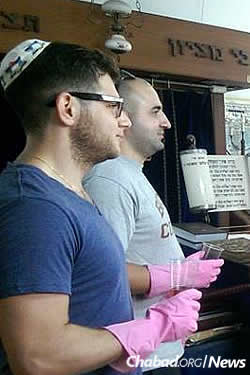
Volunteers associated with the new Chabad center take time to help clean up an abandoned synagogue in Tel Aviv.
A: We were fortunate to find a home with a really large dining room; it can hold about 30 people. That’s where we hold Shabbat dinners. We have held larger holiday programs at other venues. On the first night of Chanukah, for example, we drew as many as 200 people on a Tuesday night to Gan Ha’atzmaut (“Independence Garden”) overlooking the beach near the hotels; it was family-friendly and drew tourists as well. And on Wednesday, we held a Chanukah party called “Urban Lights” for those in their 20s and 30s, with 125 attendees. The next night, we had a “Keep Olim in Israel” party, with 300 guests. All within a matter of months. Our next big event—“The Enchanted Table”—is timed for Tu B’Shevat this month. It will also launch a series of Torah courses we are holding in English. Q: How do you connect with this eclectic crowd? A: My wife and I are from the United States: I was born in Texas and grew up in Sharon, Mass. She’s from California. At 29 and 28, we are fairly close to the ages of the young professionals we serve. We’ve been in Israel for about six years, most recently living up north in Safed. So we are just starting out in Tel Aviv as well, working to help new residents get on their feet as we acclimate at the same time. 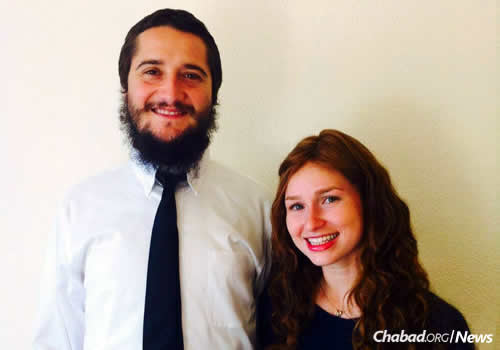
Rabbi Eliyahu (“Eli”) and Shterna Sara Naiditch, co-directors of Chabad on the Coast
In addition to holding holiday and Shabbat programs, we’re meeting people where they are. We’re going to office buildings, to their workplaces. We’re organizing social events and planning a Rosh Chodesh program for women, as well as Torah lessons on a one-on-one basis. We’re offering mezuzahs for doors, koshering kitchens and providing guidance in ways we can. We want people to feel: “I’m new in town. I can go to Chabad.” We want to make it easy for them to adjust, as my wife and I ourselves are doing. Q: What has been the reaction so far to your programs, and are you surprised by it? A: We were totally taken aback with the strong response so early on. We have met men and women from South America, Greece, former Soviet republics like Georgia and even Madagascar—pretty much everywhere in the world. We’ve meet people from places you wouldn’t have imagined Jews lived. On Dizengoff Street (the main thoroughfare in Tel Aviv), every other person speaks a different language. Everyone has their own story, their own reasons for coming here. But what they have in common is sharing life with the highest concentration of Jews of any city in the world. That’s one of the biggest blessings—to be part of the largest network of Jews anywhere. 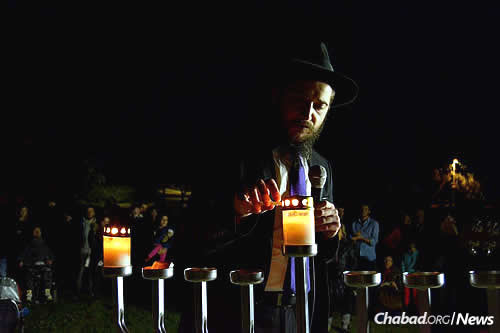
The recently established Chabad on the Coast held its very first Chanukah public menorah-lighting at a park overlooking the Tel Aviv promenade and the Mediterranean Sea. Rabbi Naiditch lit the candles in front of nearly 200 people; the lighting was followed by two other well-attended holiday events.
A: Social media has been a major success—our online presence, Facebook. So far, we estimate that we have reached close to 50,000 people about our presence and programs. Remember, people wanted this, and once they heard about us, they started coming. I love the fact that Jews from all over the world are contacting us. I can only expect that participation will grow stronger and stronger as time goes on. 
The Tel Aviv landscape: high-rise residential buildings, office towers, cultural centers and more, all within close proximity to the shore.
A: A friend came up with the name. We first considered Chabad on the Beach. Then we ran it by people and settled on this instead. It’s catchy, isn’t it? It has a great ring to it. It’s all a miracle, really.
© Copyright 2016, all rights reserved.
| ||
Jewish News
| ||
Most rabbis don’t consider close proximity to a prison a selling point when purchasing a home. But after living in Morgantown, W.V., for a few years, Rabbi Zalman Gurevitz wanted to move closer to both the University of West Virginia campus—and to the Federal Correctional Institution (FCI Morgantown) there.
Gurevitz and his wife, Hindy, have served the student body at the Rohr Chabad Jewish Student Center at West Virginia University since 2007. But he has another congregation of sorts: He visits a group of inmates at the minimum-security prison every Shabbat. He is inspired by the concern for Jewish inmates expressed by the Lubavitcher Rebbe—Rabbi Menachem M. Schneerson, of righteous memory. In the early 1980s, when incarceration rates in the United States started increasing dramatically, the Rebbe began talking more about the importance of spending time with and positively influencing people in confined environments. “As a follower of the Rebbe and a student of the Rebbe, I knew how important it was to him,” said Gurevitz, who took over the duty started by a rabbi affiliated with the Pittsburgh-based organization Aleph Northeast. When Gurevitz moved to Morgantown, he was asked to take over the visits. The Aleph Institute—a Florida-based organization founded under the direction of the Rebbe—is dedicated to assisting incarcerated Jews and their families, estimating that more than 5,000 Jews are currently in prisons across the United States. The organization also provides services and support to Jewish men and women serving in the U.S. military. 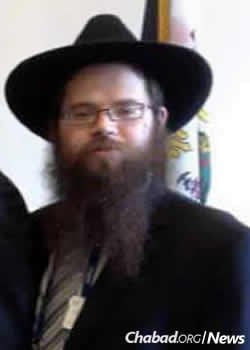
Rabbi Zalman Gurevitz
The Spiritual and the PhysicalWhen it was first suggested that Gurevitz move to West Virginia, he was a bit uncertain. However, once he and his wife arrived with two children at the time—they now have three more—“we realized how important it is to be here because if we weren’t, the needs of many Jewish students would have never been met.”Gurevitz primarily focuses on the university students. But a few months after he arrived in town, he got clearance to enter the prison. On his first visit, recalled Gurevitz, one of the inmates said, “So rabbi, you’ll be back next week the same time?” “I couldn’t say ‘no.’ So I said ‘yes,’ and I worked it out with the chaplain so we could come every week.” The group had enough people to form a minyan (a quorum of 10 Jewish men necessary for public prayer) for the first time in 2010 and received a Torah that same year. In 2011, the rabbi started walking more than two miles each way to the prison every Shabbat. (Before he moved, it had been five miles each way; he went every other Shabbat.) He notes that he is motivated in part by the Rebbe’s classic work, Hayom Yom. “When it comes to spiritual matters, you have to compare yourself to someone who is doing the better than you,” he says. “When it comes to physical matters, you have to look at someone who is in a worse situation.” 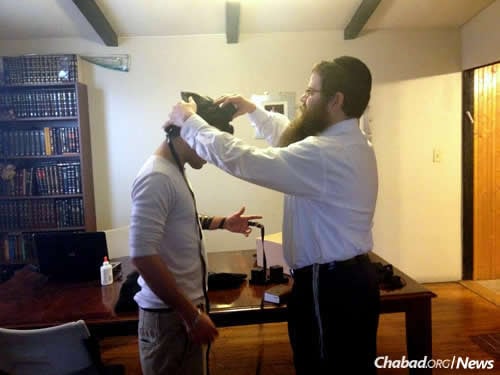
The rabbi wraps tefillin with a student.
‘A Jew Is a Jew’Steven Kern used to travel around Asia as part of a group of volunteer chiropractors, and says he would study the dominant religion within whatever country he was visiting. In 2013, after being convicted of the willful non-filing of his income-tax return, Kern was sentenced to one year in prison.There, he met some of the other Jewish inmates and started participating in services. Kern’s mother was Jewish, and he says he had read the Torah many times as part of his interest in religions, but didn’t know much about Jewish culture or prayers. Gurevitz gave him a book to help him learn Hebrew, which he did while working in the prison laundry room. Eventually, Kern, in his 40s, had his bar mitzvah ceremony with the support of the rabbi. For Kern, the time in prison was transformative. “I can say it was a wonderful experience in part because” I found my “Jewish heritage,” acknowledges Kern, who now lives in Michigan and observes Shabbat. 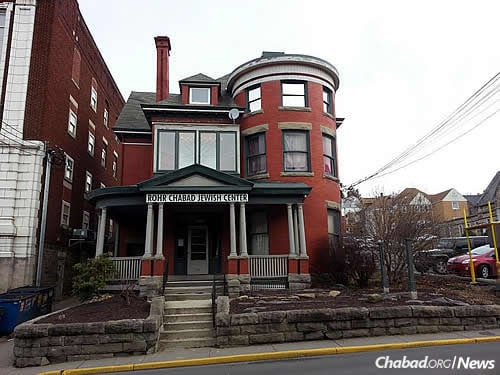
The Chabad House serving West Virginia University
Jan Ditzian, 72, is a competitive powerlifter in the 132-pound weight class and lives just over the border in Pennsylvania. He comes each week for Shabbat and also tutors inmates in Hebrew during the week. Describing the prison as “extremely safe,” he says that most of its Jewish population, which includes lawyers, accountants and doctors, is “very intelligent.” “They are good people to talk to,” says Ditzian, whose background is in industrial psychology. He had also been principal of a Jewish Sunday school in Morgantown and had previously connected with Chabad leaders in Pittsburgh. After Gurevitz moved to West Virginia, he reached out to Ditzian; eventually, the two started going to prison together. While Ditzian belongs to a local synagogue, he considers the prison “my congregation.” “They seem to be extremely appreciative, and that’s what I find rewarding about it,” he says. “They seem to like my coming.” Aside from people like Ditzian, “the general Jewish community is not ready to accept felons,” states Gurevitz. As an example, the rabbi says he once had a scheduling conflict with someone on the outside and explained that he couldn’t change his schedule because of the strict rules at the prison. The person told him, “You better teach them to be good people.” Yet the rabbi feels that “as a Chabad emissary, to me a Jew is a Jew, no matter what they did.” After all this time working in the field, the rabbi says the subject of criminal justice has become somewhat personal. In fact, with recent talk of prison reform at the national level aiming to lower the incarceration rate, Gurevitz quips: “I’m the only rabbi who will be happy when I lose my minyan.” 
The rabbi and his wife, Hindy, primarily provide Jewish programming, classes, services and more for students, though the rabbi's work with inmates is an important part of his shlichus.
© Copyright 2016, all rights reserved.
| ||
Jewish News
| ||
Sixth in a series of articles on the 40th anniversary of the worldwide kosher campaign launched by the Rebbe in 1975.
As predictions of the mammoth snowstorm that dumped more than two feet of snow on New York City over the weekend gusted through the news earlier in the week, Sandra Justin brought her three children—Ethan, 9; Zoe, 12; and Talia, 14—to help pack boxes kosher food staples for those in need. They joined some 40 other volunteers as part of the Chabad Relief Project, an affiliate of Chabad Lubavitch of Midtown Manhattan, which works to assemble and distribute packages of kosher items each month to go to Jews grappling with putting food on their tables. For anyone who thinks hunger is not a problem among New York’s Jewish population, those affiliated with the relief project know very well that it is. And as the snow indeed walloped the city this weekend, the food delivered earlier in the week proved especially beneficial for the needy, many of whom are elderly. The organization’s 2016 kickoff event was co-sponsored by Fifth Avenue Synagogue and the Chabad Relief Project. While they’ve had groups of volunteers before, this marked the first official partnership with a synagogue, according to Rabbi Noach Heber, director of the Chabad Relief Project. “We plan to offer this to other synagogues as well, bringing their own volunteers to pack the boxes of food,” said Heber. “The plan is to have different groups come every month to join us.” Fifth Avenue Synagogue members—some of whom, like Justin, are also active with the Chabad Relief Project—teamed up with some regulars and guests to pack 200 boxes of nonperishable food for delivery around Manhattan. 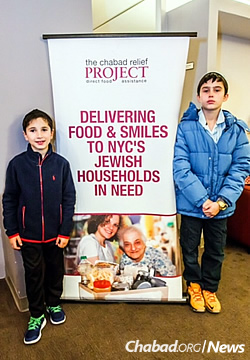
All ages were on hand to help.
But first, participants took a short break, chatting over slices of pizza. Sandra Justin and her husband, Jeffrey, have volunteered with the project since its start four years ago. At last week’s event, they were presented with the Chabad Relief Project’s “Letaken Olam” (“Repair the World”) award, instituted this year to go to a Jewish Manhattanite or couple for their efforts in fighting food insecurity. Getting the award came as a surprise, according to Jeffrey Justin, a trustee of Fifth Avenue Synagogue. “The real award is everybody here; this is very special,” he said, adding the importance of getting the word out about the Chabad Relief Project. “We come here and pack boxes and deliver them to people in need. You do good; you feel good.” Many of the recipients are Holocaust survivors, like his own parents. “It’s an important thing to do, and it’s important that people give of themselves,” he explained. “My whole family is here—people I know and I respect are here—it’s just a pleasure.” 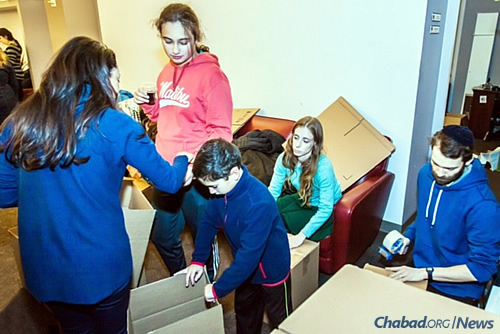
The younger set worked to organize and tape the boxes together before packing.
‘All of Us Get to Perform a Mitzvah’The Chabad Relief Project started in 2012 with a few pilot runs to assist about two-dozen people who called Chabad of Midtown for help. It delivers to the elderly, disabled, parents of disabled children, and under- and unemployed individuals who have difficulty going to a food bank, either because of logistics or embarrassment.Heber says he intends to expand the project further this year: “We plan on growing this year to serve as many as 300 people. There are many people in Manhattan who need our help.” Dr. Walter Molofsky, chairman of the board of Fifth Avenue Synagogue, says the event was moving and successful, and that he would participate again if asked. “It informs people who might not know otherwise about the need for this kind of service,” he said. “It’s educational, and it has a functional aspect to it. And all of us get to perform a mitzvah.” Rivkah Rothschild, an attorney who assists with infrastructure work for the Chabad Relief Project and is also very involved with Fifth Avenue Synagogue, says she now makes packing and delivery a part of her routine. “I did this once or twice, and I was hooked,” she said. “Like calcium—you need calcium in your diet—I needed this in my life.” 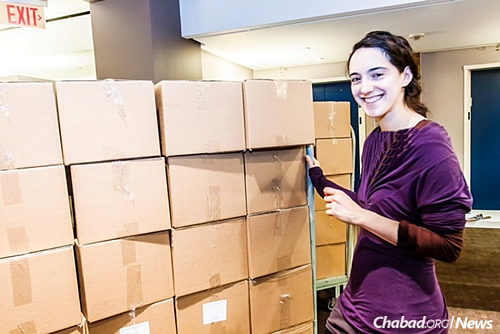
Nadia Talel helps stack the packed boxes, all ready to be delivered to homes of the needy.
Jon Harari, 33, started volunteering with Chabad Relief Project about a year ago and comes as often as he can. Tuesday was his sister’s birthday, and since she lives in Florida, he decided to volunteer in her honor and posted the opportunity to his Facebook page in case anyone wanted to join in as well. He noted that delivering directly to the recipients is very powerful: “The person-to-person interaction really shows others that someone cares about them.” Ivan Khafif, 8, came to the event with his mom. He spent the evening preparing the boxes for filling. On his way back down the elevator after the event, he summed it up in three words: “Fun. Fantastic. Exciting.” As for Sandra Justin, she hopes her kids came away with a sense of the impact of their work, saying that “sometimes, giving even an hour of your time makes a big difference.” Moreover, she added, “working together as a community gets things done.” 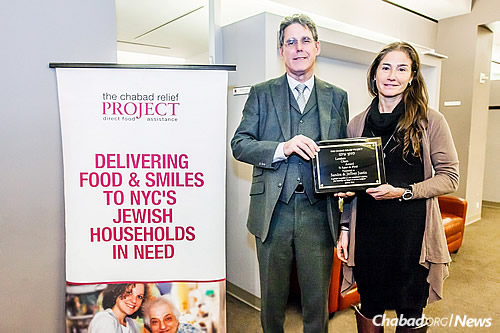
Longtime volunteers Jeffrey and Sandra Justin received the Chabad Relief Project’s “Letaken Olam” award on Tuesday night, instituted this year to a Jewish Manhattanite or couple for their efforts in fighting food insecurity.
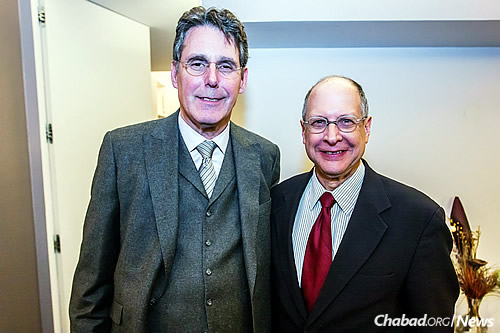
Jeffrey Justin, left, and Dr. Walter Molofsky, who said the event was both moving and successful.
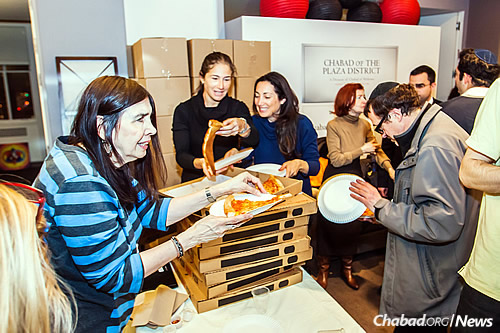
Taking time out for a pizza break.
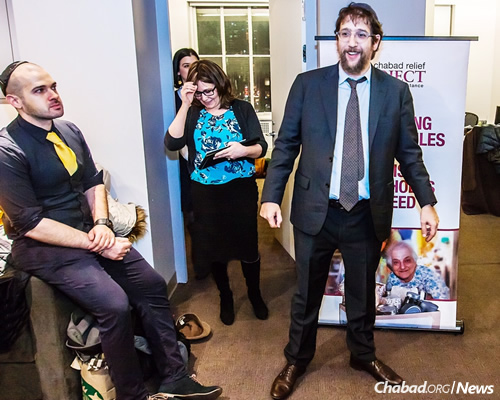
The food distribution takes place monthly, overseen by Rabbi Noach Heber, director of the Chabad Relief Project. To his left is regular volunteer Rivkah Rothschild; to her left is Jon Harari, who has been helping out for the past year and who attended the packing last week in honor of his sister's birthday.
First Kosher Kitchen an Entranceway to a More Spiritual Life Q&A: Tools of the Koshering Trade: Pots, Rocks, Blow Torch Keeping Kosher at the Last Stop Before the South Pole Q&A: 40 Years Later, Leaders Savor the Details of Kosher Campaign’s History How One Purple Book Revolutionized Kosher Cooking
© Copyright 2016, all rights reserved.
| ||
Jewish News
| ||
Welcome to Eugene, where tie-dye and Birkenstocks are the garb of choice, environmentalism is a like a religion, residents grow their own vegetables, and bicycles are the preferred means of transportation. It is into this atmosphere that Rabbi Berel and Rivkah (Rivky) Gurevitch—and their year-old twin daughters—have planted themselves to run a campus Chabad House at the University of Oregon, Eugene.
Located just 10 minutes from campus in the heart of student housing, the Chabad center is already outgrowing the small townhouse that so far has served as a haven for the university’s roughly 1,600 Jewish students and the town’s 2,000 Jewish residents. “I love how they’re very welcoming and warm. They’re just so available. I live only a few blocks away from them,” says senior political-science major Margaret Butler, who hails from nearby Portland and plans to help the Gurevitches reach out to more students this semester. “They’re the nicest people. They’re always interested about my life, and it has been so interesting for me to learn about Judaism from them.” 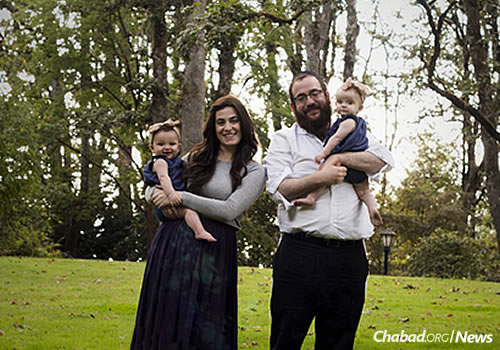
The Gurevitch family
“The Friday-night dinners at Chabad feel like a piece of home for me,” says freshman psychology major Sarah Bonner, from Irvine, Calif. “I love the family-based meal. It’s something different from all of the other things we have had so far on campus; it really feels like Shabbat should.” Rivky Gurevitch notes that they will also start inviting students to their home for dinner during the week, a few at a time to make it more personal. 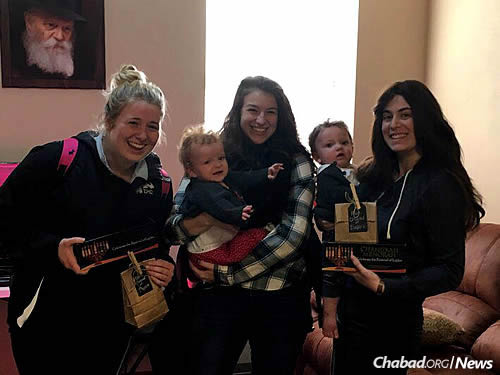
Margaret Butler, left, and Erin Horwitz at Chanukah time with menorah kits given by Rivky Gurevitch.
‘Not Just a Cliché’Since moving to Eugene, the Gurevitches have received a warm welcome from the local community even if the weather has been less cooperative: It rains practically every day in the winter.“Even in the seven short weeks since we’ve been here, we’ve gotten a very positive response from students; they’re very into it,” said Rabbi Gurevitch, 26, who has assisted at various Chabad centers worldwide (England, Norway, Michigan, Texas) and is the fifth of his siblings to open a Chabad House of his own. “They like the feeling of having Chabad as a place to call home. It’s a real thing, not just a cliché.” Beginning this month, Chabad will be an official, university-recognized organization, which will enable them to staff information tables on campus, as well as use the school’s classrooms for meetings and programs, such as the new “Pizza & Parsha” class they plan to offer. 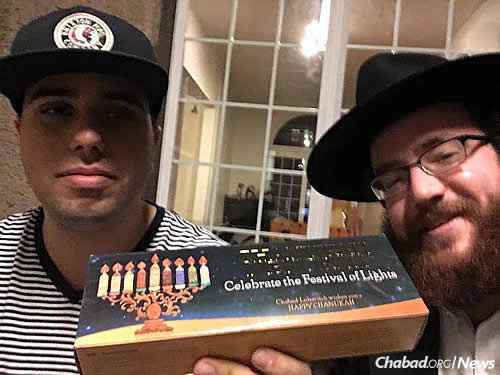
Student Jonathan Benaroch gets a menorah from the rabbi.
“We were thrilled to come here, and I absolutely love doing this. Our life’s dream was to become Chabad emissaries,” says Rivky Gurevitch, 22, who descends from multiple generations of Chabad-Lubavitch emissaries. “Even though we’re far away from friends and family, it makes us feel that we have a true purpose, and that we’re making a difference by giving people Jewish experiences. People have been much more open to us that we could have ever imagined.” 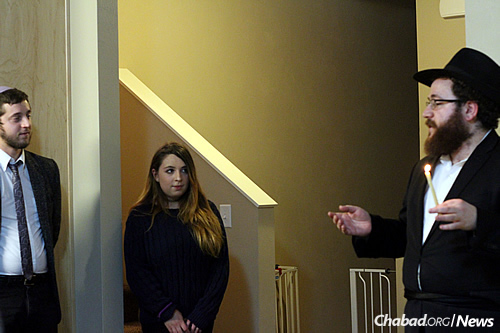
Rabbi Gurevitch leads Chanukah events for University of Oregon students; the mainstay of Chabad programming began in October.
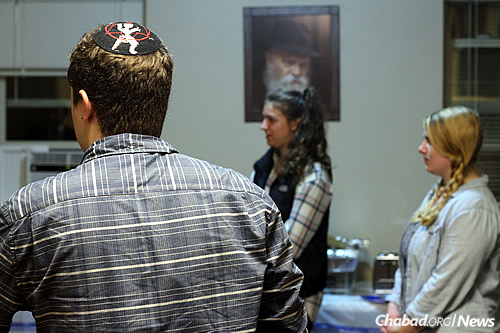
The Chabad center is located 10 minutes from campus in the heart of student housing, and is already starting to outgrow its space.
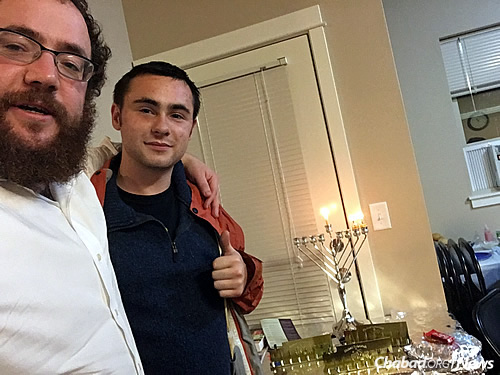
The Gurevitches have been meeting students one-on-one, offering mezuzahs and hosting parties, including a “Midnight Breakfast” Chanukah celebration during finals this past semester.
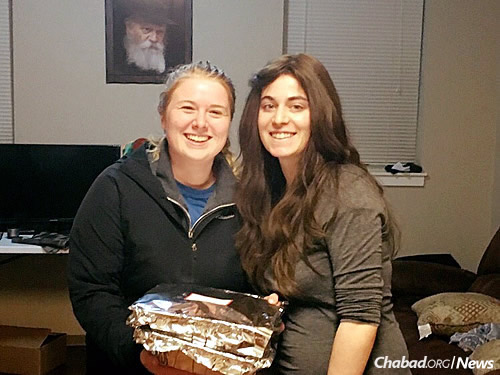
Rivky Gurevitch gave out challah to students who stayed in town over Thanksgiving weekend, including Margaret Butler.
© Copyright 2016, all rights reserved.
|
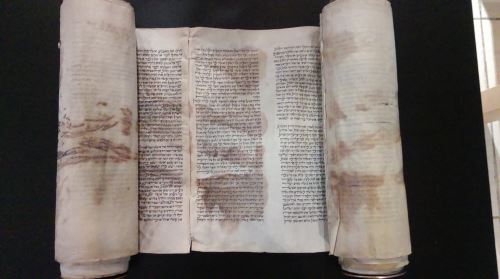
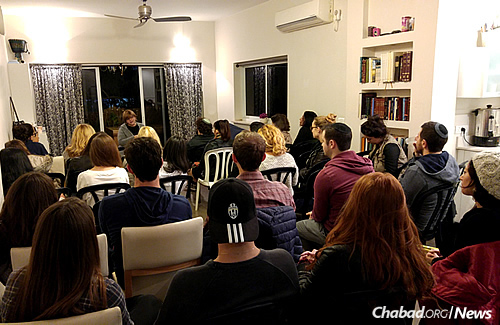

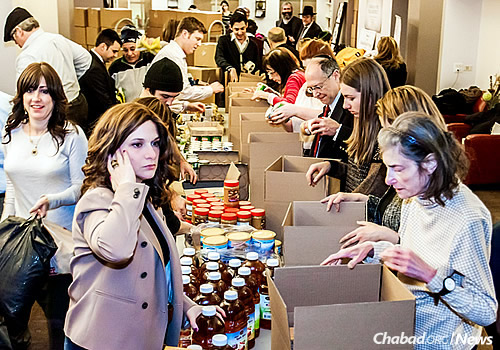
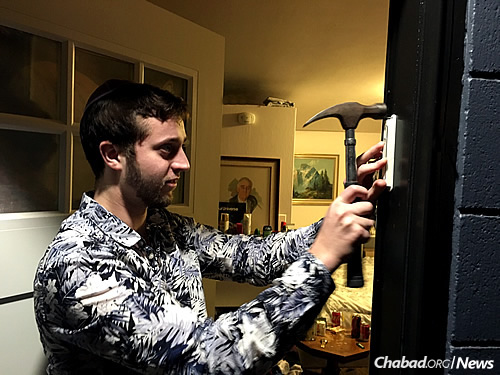
Hello, i am from USA, I want to share this great testimony about how Dr.Agbazara helped me bring back my ex lover, During my search for solution i came in contact with Dr.Agbazara details and through his help my lover came back to me within 48 hours. So with these i am so bold to advise anyone seeking for a way to get there lover back to contact Dr.Agbazara on WhatsApp: { +2348104102662 } or via email at: { agbazara@gmail.com } I am so happy at least myself and my lover are back to each other again and going to spend the New Year celebration together Thank to Dr.Agbazara once again....
ReplyDelete